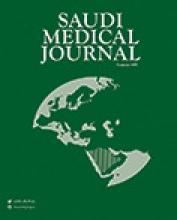To the Editor
I read with interest the study by Jamjoom and Park on the assessment of pediatric residents burnout in a tertiary academic centre in Saudi Arabia.1 On employing Maslach Burnout Inventory-Human Services Survey (MBI-HSS), the authors found that more than 70% of residents experiencing severe burnout.1 I presume that such percentage ought to be cautiously taken. This is based on the presence of the following 2 methodological limitations related to the MBI used to measure burnout in the studied cohort. 1) It is obvious that MBI is an old self-assessment tool constructed in the 1970s. It involves 3 dimensional burnout constructions, namely depersonalization, emotional exhaustion, and reduced performance ability and/or motivation. But the cutoff points do not conform to the standards of scientifically valid test construction. Moreover, many key questions included in MBI-HSS questionnaire are applicable to other sicknesses like depression, feeling unwell, and the concept of prolonged exhaustion and, hence, it is difficult to make a sharp distinction between burnout and these sicknesses.2-4 There is yet no standardized and international valid tool to precisely diagnose burnout. 2) Jamjoom and Park1 employed the original English version of MBI-HSS to assess burnout in the studied population. It is noteworthy that certain populations-specific versions of MBI-HSS have been constructed to be employed in the clinical field and reaserches.5,6 I presume that construction of Saudi version of that tool could better delineate the actual size of burnout in the medical profession. Despite the above-mentioned limitations, the high percentage of burnout reported by Jamjoom and Park1 is worrisome. Therefore, systemic programs are needed within the Saudi health system with the objectives of minimizing pediatric residents’ impairment due to burnout on one hand and promoting their educational and professional perspectives on the other.
Reply from the Author
I am glad that Dr. Al-Mendalawi found our article of interest and use. About your mentioned points in regards to Maslach’s tool, despite it had been established in the 1970s, it went under multiple revisions and it is the most used validated tool in the area of medical burnout to date. I do agree that the diagnosis of the condition is challenging and we elected to use the tool that will allow our results to be comparable nationally and internationally.
I agree that using an Arabic version rather than “Saudi” would be better. Unfortunately, I could not gain access to the validated Arabic version. Plus, our residents were comfortable taking this test since English is the language used in medical school, residency and daily rounds.
Again, I appreciate your correspondence.
Roaa Jamjoom
Pediatric Emergency, King Abdulaziz University Hospital, Jeddah, Kingdom of Saudi Arabia
- Copyright: © Saudi Medical Journal
This is an open-access article distributed under the terms of the Creative Commons Attribution-Noncommercial-Share Alike 3.0 Unported, which permits unrestricted use, distribution, and reproduction in any medium, provided the original work is properly cited.






